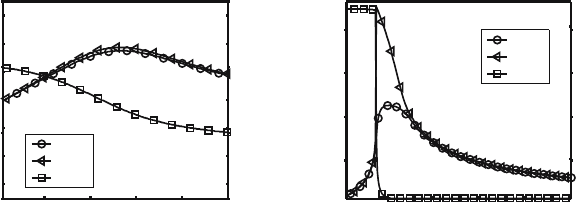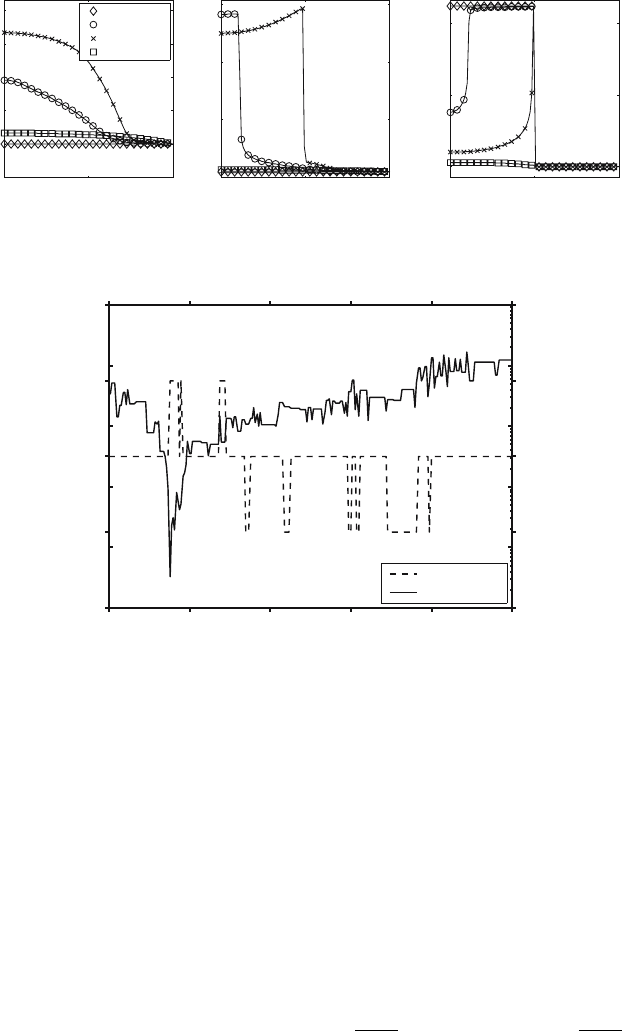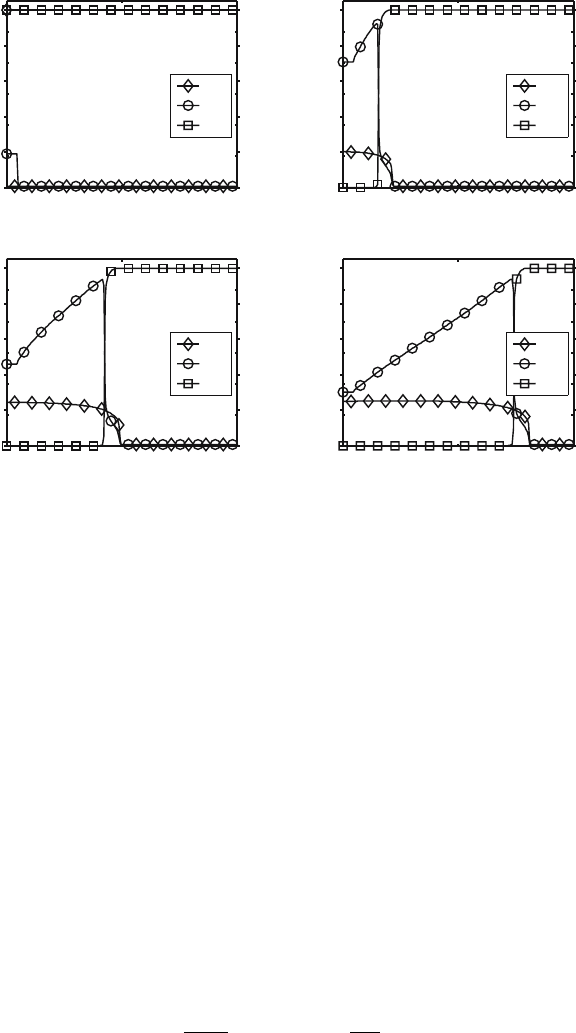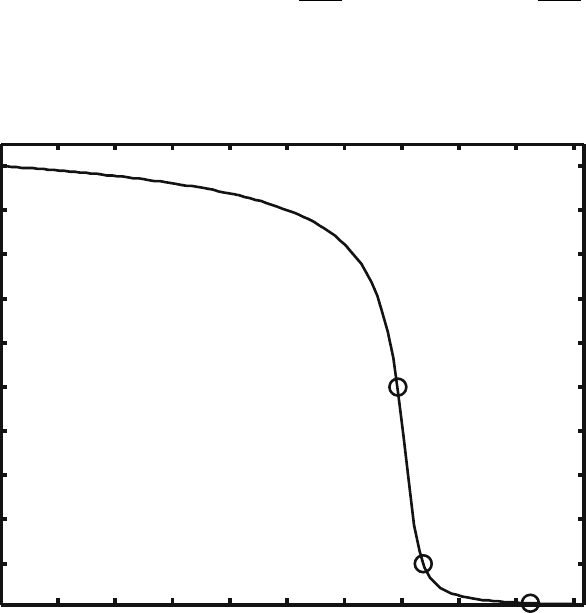Graziani F. (editor) Computational Methods in Transport
Подождите немного. Документ загружается.


356 D.E. Shumaker and C.S. Woodward
we can write our discrete equations in terms of a discrete diffusion operator
given by
L(E
R
) ≡
L
1,1,1
(E
R
), ···,L
N
x
,N
y
,N
z
(E
R
)
T
, (4)
a local coupling operator given by
S(E
R
, E
M
) ≡ (S
1,1,1
(E
R
, E
M
), ···,S
N
x
,N
y
,N
z
(E
R
, E
M
))
T
, (5)
and the local reaction rate operator given by
R(E
M
,ρ
F
) ≡ (R
1,1,1
(E
M
,ρ
F
), ···,R
N
x
,N
y
,N
z
(E
M
,ρ
F
))
T
, (6)
where, as in [8]
L
i,j,k
(E
R
) ≡
D
i+1/2,j,k
E
R,i+1,j,k
− E
R,i,j,k
∆x
i+1/2,j,k
− D
i−1/2,j,k
E
R,i,j,k
− E
R,i−1,j,k
∆x
i−1/2,j,k
/∆x
i
(7)
+
D
i,j+1/2,k
E
R,i,j+1,k
− E
R,i,j,k
∆y
i,j+1/2,k
− D
i,j−1/2,k
E
R,i,j,k
− E
R,i,j−1,k
∆y
i,j−1/2,k
/∆y
j
+
D
i,j,k+1/2
E
R,i,j,k+1
− E
R,i,j,k
∆z
i,j,k+1/2
− D
i,j,k−1/2
E
R,i,j,k
− E
R,i,j,k−1
∆z
i,j,k−1/2
/∆z
k
with the diffusion coefficients evaluated on the face centers,
D
i+1/2,j,k
≡
c
3ρ
i+1/2,j,k
κ
R,i+1/2,j,k
+ ∇E
R
i+1/2,j,k
/E
R,i+1/2,j,k
,
D
i−1/2,j,k
≡
c
3ρ
i−1/2,j,k
κ
R,i−1/2,j,k
+ ∇E
R
i−1/2,j,k
/E
R,i−1/2,j,k
,
with y and z terms similarly defined,
S
i,j,k
(E
R,i,j,k
,E
M,i,j,k
)=cρ
i,j,k
κ
P,i,j,k
aT
4
M,i,j,k
− E
R,i,j,k
, (8)
and
R
i,j,k
(E
M,i,j,k
,ρ
F,i,j,k
)=σ
v
ρ
2
F,i,j,k
T
M,i,j,k
T
0
5
. (9)
Thus, our discrete scheme is to find E
R
(t)andE
M
(t)suchthat,
dE
R
dt
= L(E
R
)+S(E
R
, E
M
), (10)
dE
M
dt
= −S(E
R
, E
M
)+e
r
R(E
M
,ρ
F
), (11)
dρ
F
dt
= −R(E
M
,ρ
F
). (12)
For more details, see [7, 8].

Implicit Solution of Non-Equilibrium Radiation Diffusion 357
3.2 Time Integration and Solvers
We formulate (10)–(12) as an implicit system of ordinary differential equa-
tions (ODEs) and use an ODE time integrator to handle the implicit time
step selection. In particular, we employ the parallel ODE solver, CVODE [17],
developed at Lawrence Livermore National Laboratory and included in the
SUNDIALS package [18]. CVODE employs the fixed leading coefficient vari-
ant of the Backward Differentiation Formula (BDF) method [19, 20] and al-
lows for variation in the order of the time discretization as well as in the time
step size. Time step sizes are chosen to minimize the local truncation error
and thus give a solution that obeys a user-specified accuracy bound.
This time integration technique leads to a coupled, nonlinear system of
equations that must be solved at each time step. For example, solving the
ODE system
˙y = f(t, y), (13)
with the backward Euler method leads to the following nonlinear system
y
n
− y
n−1
∆t
= f(t
n
,y
n
) (14)
that must be solved at each time step. For the solution of this system, we use
an inexact Newton–Krylov method with Jacobian-vector products approxi-
mated by finite differences. As the methods in CVODE are predictor-corrector
in nature, an explicit predictor (e.g., forward Euler in the case above) is used
for an initial guess in the nonlinear solve.
In the methods discussed above, we use the scaling technique incorpo-
rated into CVODE. Thus, we include an absolute tolerance (ATOL) for each
unknown and a relative tolerance (RTOL) which is applied to all unknowns.
These tolerances are then used to form a weight which is applied to each so-
lution component during the time step from t
n−1
to t
n
. This weight is given
as
w
i
= RT OL|y
i
n−1
| + AT OL
i
(15)
and is also used to weight a root mean square norm
y
WRMS
=
N
−1
N
1
(y
i
/w
i
)
2
1/2
(16)
which is applied to all error-like vectors within the solution process.
We use the GMRES Krylov iterative solver for solution of the linear Ja-
cobian system at each Newton iteration [21]. The tolerance for the Newton
iteration is taken to guarantee that iteration error introduced from the non-
linear solver is smaller than the local truncation error. For more details re-
garding the step size and order selection strategies in CVODE, as well as
acceptance of a step and nonlinear convergence, we refer the reader to the
review article [18].
358 D.E. Shumaker and C.S. Woodward
3.3 Preconditioning
Preconditioning is generally essential when using Krylov linear solvers. To
describe our preconditioning strategy, we begin by considering the content
and structure of the Jacobian matrix. In (13), set y =(E
R
T
, E
M
T
,ρ
F
T
)
T
,
and then form f using the right-hand sides of (10)–(12). The Jacobian ma-
trices used in the Newton method are of the general form F
(y)=(I − γJ),
where J = ∂f/∂y is the Jacobian of the nonlinear function f,andthepa-
rameter γ ≡ ∆tβ with ∆t the current time step value and β acoefficient
depending on the order of the BDF method. Recalling the definitions of the
discrete divergence, coupling and reaction rate operators, the block form of
the Jacobian of f is
J =
⎛
⎝
∂L/∂E
R
+ ∂S/∂E
R
∂S/∂E
M
0
−∂S/∂E
R
−∂S/∂E
M
+ e
r
∂R/∂E
M
e
r
∂R/∂ρ
F
0 −∂R/∂E
M
−∂R/∂ρ
F
⎞
⎠
=
⎛
⎝
A + GB 0
−G −B + e
r
Ce
r
H
0 −C −H
⎞
⎠
,
where A = ∂L/∂E
R
, G = ∂S/∂E
R
, B = ∂S/∂E
M
, C = ∂R/∂E
M
,and
H = ∂R/∂ρ
F
. We note that G, B, C and H are diagonal matrices. In all
of our preconditioning strategies, we neglect the nonlinearity in the diffusion
term and use the approximation [7, 8]
A = ∂L(
ˆ
E
R
)/∂E
R
≈
ˆ
L(
ˆ
E
R
) ≡
˜
A,
where ∂L(
ˆ
E
R
)/∂E
R
is the Jacobian of L evaluated at a radiation energy,
ˆ
E
R
.
The size of the neglected term is related to the derivatives of the Rosseland
opacity and the flux-limiter. Our motivation for neglecting this term arises
from the fact that −
˜
A is symmetric and positive definite, whereas −A is not,
and we thus can use multigrid methods for solution of diffusion terms within
the preconditioner.
Our preconditioning strategy is to factor the matrix, M ≡ I − γ
˜
J,as
⎛
⎝
PQ0
UTV
0 YZ
⎞
⎠
≡
⎛
⎝
I − γ(
˜
A + G) −γB 0
γG I − γ(e
r
C − B) −γe
r
H
0 γC I + γH
⎞
⎠
= M
The preconditioner solve then consists of solving M
Schur
x = b for x where,
M
Schur
=
⎛
⎝
IQ
˜
T
−1
0
0 IVZ
−1
00 I
⎞
⎠
⎛
⎝
S 00
0
˜
T 0
00Z
⎞
⎠
⎛
⎝
I 00
˜
T
−1
UI 0
0 Z
−1
YI
⎞
⎠
(17)
with S = P − Q
˜
T
−1
U and
˜
T = T − VZ
−1
Y. Thus,

Implicit Solution of Non-Equilibrium Radiation Diffusion 359
⎛
⎝
x
1
x
2
x
3
⎞
⎠
=
⎛
⎝
S
−1
(b
1
− Q
˜
T
−1
˜
b
2
)
˜
T
−1
(
˜
b
2
− Ux
1
)
Z
−1
(b
3
− Yx
2
)
⎞
⎠
(18)
where
˜
b
2
= b
2
− VZ
−1
b
3
.
If the Schur complement, S, is exactly inverted, there will be no error
associated with this preconditioner for the non-flux-limited, constant opacity
case. In addition, because G, B, C, H and hence
˜
T and Z are diagonal, there
is no penalty associated with inverting
˜
T for every iteration of a method that
inverts S. Also note that S is formed by modifying the diagonal of P and thus
is composed of a symmetric diffusion-like matrix with a modified diagonal.
Hence, we can employ multigrid methods to invert this Schur complement.
Dependence of opacities on temperatures can give rise to large spatial
gradients and thus a very heterogeneous problem. Hence, to invert the Schur
complement matrix, S, we use a multigrid method designed to handle large
changes in problem coefficients. In particular, we use one V-cycle of the semi-
coarsening multigrid algorithm developed by Schaffer [23,24] as our multigrid
solver. Semi-coarsening multigrid methods have been found to be quite ef-
fective on highly heterogeneous problems [25]. Details of this method can be
found in the cited references, and more information about multigrid methods
in general can be found in [26].
4 Results
In this section we demonstrate the above solution method on the implicit
formulation of (1)–(3). In the first two subsections we present illustrations of
problems modeled by this system of equations. In the next two subsections
we give results which verify the accuracy and convergence of the method.
4.1 1D Solution Illustration
In this section we illustrate how the time evolution of the solution is af-
fected by the initial fuel density. This 1D problem has a domain from 0 cm
to 10.0 cm discretized with 100 grid points. The fuel is initialized using a
step function with fuel density,
ρ
F 0
, on the left half of the domain and 0
on the right. The initial radiation and material temperatures are equal and
constant in the domain. Neumann boundary conditions are applied on the
left boundary,
∂E
R
∂x
= 0, while Dirichlet boundary conditions are applied on
the right boundary with the temperature set to the initial value. The relative
tolerance requested was RTOL = 10
−7
, and the absolute tolerances were set
for temperatures and fuel density as 10
−6
, 10
−6
,and10
−24
for the radiation,
material, and fuel density, respectively.
Results are presented for two different initial conditions; one with a high
fuel density, and the other with a low fuel density. The high density simulation

360 D.E. Shumaker and C.S. Woodward
has ρ
F 0
of 0.03 g/cm
3
and T
R
= T
M
of 0.5 keV. The low density simulation
uses ρ
F 0
=0.01 g/cm
3
and T
R
= T
M
=0.776 keV. These initial temperatures
were selected so that the initial heating rates,
ρ
2
F
T
5
M
, are approximately the
same for both simulations.
Figure 1 illustrates the evolution of the radiation and material temper-
ature, as well as fuel density of a point near the left boundary. As can be
seen, the high density case yields a very rapid increase in material tempera-
ture and consumes most of the fuel. The low density case results in a slower
evolution of the material temperature. The slowly changing temperature al-
lows for more energy to be transfered to the radiation and loss via diffusion.
Since the temperature is lower in this case, a smaller fraction of the fuel is
consumed.
0.01 0.02 0.03 0.04 0.05
0.2
0.4
0.6
0.8
1
1.2
1.4
Temperature (keV)
time (µs)
0
0.005
0.01
0.015
Fuel Density (g/cm
3
)
ρ
F0
= 0.01
T
R
T
M
ρ
F
0.01 0.02 0.03 0.04 0.05
10
0
10
1
Temperature (keV)
time (µs)
10
−5
10
−4
10
−3
10
−2
Fuel Density (g/cm
3
)
ρ
F0
= 0.03
T
R
T
M
ρ
F
Fig. 1. Evolution of radiation temperature, material temperature, and fuel density
for two simulations. Values plotted are for a point near the left boundary. Linear
scale used on the low density case and a log scale used on the high density case
Figure 2 shows profiles of radiation temperature, material temperature,
and fuel density at various times for the
ρ
F 0
=0.03 g/cm
3
simulation. Diffu-
sion loss of energy results in a lower temperature in the outer region. Thus,
the inner region begins to consume fuel and heat up sooner than the outer
region resulting in a steep temperature gradient that sweeps through the fuel
region (see Fig. 2). These results are similar to the reaction-diffusion wave
results presented in the next section.
Figure 3 gives the history of the time step and integration order for the
higher fuel density case. The smallest step size, which occurs during the
rapid heating stage, is 3.26 × 10
−8
µs. The longest time, in the quiescent
period at the end of the simulation, is 5.31 × 10
−4
µs. This large difference
in step sizes illustrates the ability of our method to select time step size and
integration order resulting in the largest time step possible subject to the
accuracy constraints.

Implicit Solution of Non-Equilibrium Radiation Diffusion 361
0510
0
0.5
1
1.5
2
2.5
Radiation Temperature
(keV)
r (cm)
t =0.0002 µs
t =0.0076 µs
t =0.0082 µs
t =0.0598 µs
0510
0
5
10
15
Material Temperature
(keV)
r (cm)
0510
10
6
10
4
10
2
Fuel Density
(g/cm
3
)
r (cm)
Fig. 2. Radiation temperature, material temperature and fuel density profiles at
various times for the ρ
F 0
=0.03 g/cm
3
run
0 0.01 0.02 0.03 0.04 0.05
1
2
3
4
5
Order
time (µs)
Order
Time Step
10
−8
10
−7
10
−6
10
−5
10
−4
10
−3
Time Step (µs)
Fig. 3. History of time step and integration order
4.2 1D Reaction Diffusion Wave
In the previous section we initialized the simulation with a uniform initial
material temperature and a step function for the initial fuel density. The sim-
ulation in this section begins with a uniform fuel density and a step function
in the initial material temperature. These initial conditions produce a reac-
tion diffusion wave which is propagated by the diffusion of radiation energy
and is driven by the energy from the fusion reaction.
The 1D domain for this simulation is 0.0to2.0 cm, with a uniform fuel
density of 0.1 g/cm
3
, and uses 200 grid points. The initial background radia-
tion and material temperatures are set to 0.1 keV except for a small region on
the left from 0 to 0.1 cm where the material energy is initialized to 2.0keV.
The reaction parameters are, σ
v
=1.43×10
3
cm
3
sec−g
and e
r
=1.35×10
18
erg
sec−g
.

362 D.E. Shumaker and C.S. Woodward
0 0.5 1
0
2
4
6
8
10
12
Temperature (keV)
r (cm)
Time = 0.00000 µs
0
0.02
0.04
0.06
0.08
0.1
Fuel Density (g/cm
3
)
T
R
T
M
ρ
F
0 0.5 1
0
2
4
6
8
10
12
Temperature (keV)
r (cm)
Time = 0.00030 µs
0
0.02
0.04
0.06
0.08
0.1
Fuel Density (g/cm
3
)
T
R
T
M
ρ
F
0 0.5 1
0
2
4
6
8
10
12
Temperature (keV)
r (cm)
Time = 0.00060 µs
0
0.02
0.04
0.06
0.08
0.1
Fuel Density (g/cm
3
)
T
R
T
M
ρ
F
0 0.5 1
0
2
4
6
8
10
12
Temperature (keV)
r (cm)
Time = 0.00090 µs
0
0.02
0.04
0.06
0.08
0.1
Fuel Density (g/cm
3
)
T
R
T
M
ρ
F
Fig. 4. Profiles at various times for a reaction diffusion wave moving from left to
right
This simulation also uses the LEOS equation-of-state data base [13] for hy-
drogen.
The high density region begins to heat much faster than the remainder
of the domain. Diffusion of radiation energy heats the material in front of
the wave leading to more heating due to the fusion reactions. Figure 4 gives
profiles at four different times.
4.3 0D Analytic Test
In this section we demonstrate accuracy of the implicit solution for fusion
heating of the material and the fuel evolution by a comparison with an ana-
lytic solution.
In order to obtain the analytic results, two simplifying assumptions are
made. First, we assume κ
P
= 0. This assumption eliminates the exchange of
energy between radiation and material and thus removes the radiation energy
equation and diffusion from the system. With this assumption the material
energy equation reduces to,
∂E
M
∂t
= e
r
σ
v
ρ
F
2
T
M
T
0
5
. (19)

Implicit Solution of Non-Equilibrium Radiation Diffusion 363
Second, the relationship between E
M
and T
M
, normally determined by tables
in LEOS, is replaced by the simple linear relation, E
M
= ρc
v
T
M
,wherethe
specific heat, c
v
, is assumed to be a constant.
From the coupled pair of (19) and (3), it can be shown that the sum of
the material energy, E
M
, and the potential nuclear energy, e
r
ρ
F
,
W = E
M
+ e
r
ρ
F
, (20)
is independent of time. Thus we can use the conservation relation,
E
M
(t)+e
r
ρ
F
(t)=E
M0
+ e
r
ρ
F 0
, (21)
to eliminate E
M
(t) from (3), which becomes,
∂
ρ
F
∂τ
= −
ρ
2
F
(τ)(b − ρ
F
(τ))
5
, (22)
where b = E
M0
/e
r
+ ρ
F 0
and τ = σ
v
(
e
r
ρc
v
T
0
)
5
t, and where the initial fuel
density and material energy are
ρ
F 0
and E
M0
, respectively.
With some help from Mathematica the solution can be expressed as a
transcendental equation,
L(
ρ
F 0
)+P (ρ
F 0
) − L(ρ
F
(τ)) − P (ρ
F
(τ)) = τ, (23)
where L and P are given by,
L(
ρ
F
(τ)) =
5
b
6
(log(ρ
F
(τ)) − log(ρ
F
(τ) − b)) , (24)
and,
P (
ρ
F
(τ)) =
−4b
4
+
500
12
b
3
ρ
F
(τ) −
260
3
b
2
ρ
2
F
(τ)+70bρ
3
F
(τ) − 20ρ
4
F
(τ)
4b
5
(b − ρ
F
(τ))
4
ρ
F
(τ)
.
(25)
This analytic result can be used in two different ways. We could solve the
transcendental (23) for
ρ
F
(τ) at a number of different times, τ , then compare
these values with the computed solution from our code. Or, we could use (23)
to solve for τ when
ρ
F
(τ) is some fraction, α, of the initial value, ρ
F
(0). We
chose the latter method, since it avoids any computation error associated
with a transcendental solution. The time at which
ρ
F
(τ)=αρ
F 0
is obtained
from (23),
τ
α
= L(ρ
F 0
)+P (ρ
F 0
) − L(αρ
F 0
) − P (αρ
F 0
) (26)
The τ, and thus t, determined by the above equation, is used to verify
our solution. After we have established the parameters for a test run and
selected a value for α, we use this equation to determine a stopping time
for the simulation. The simulation computes the final fuel density, and this
density is then compared to the expected α
ρ
F 0
.

364 D.E. Shumaker and C.S. Woodward
For this test problem we use the following parameters, ρ =1.0 g/cm
3
,
c
v
=5.755 ×10
14
erg/keV, e
r
=1.35 ×10
6
erg
sec−g
,andσ
v
=1.43 ×10
3
cm
3
sec−g
.
The initial material temperature is 50.0 keV, and the initial fuel density is
0.1 g/cm
3
. We chose three values of α, (0.5, 0.1 and 0.01), to determine check
point times. These times are indicated on Fig. 5 which gives the fuel density
versus time for this simulation.
0 0.2 0.4 0.6 0.8 1 1.2 1.4 1.6 1.8 2
x 10
−6
0.01
0.02
0.03
0.04
0.05
0.06
0.07
0.08
0.09
0.1
Fuel Density (g/cm
3
)
time (µs)
Fig. 5. Evolution of fuel density for 0D analytic comparison test problem. Markers
indicate the compared test values at
ρ
F
=0.5 ρ
F
(0), ρ
F
=0.1 ρ
F
(0) and ρ
F
=
0.01
ρ
F
(0)
Table 1 gives the relative error in fuel density for values of RTOL from
10
−4
to 10
−12
along with the number of time steps, NST. Note that absolute
tolerances were set to equal the relative tolerances. We see that the error
decreases linearly with the RTOL value indicating good convergence of the
implicit solution method. We also see a fairly large increase in the number
of time steps required to resolve the solution for RTOL values less than
10
−8
. As one would expect, requiring very high accuracy comes at a price in
computation time.

Implicit Solution of Non-Equilibrium Radiation Diffusion 365
Table 1. Statistics and Error for 0D Analytic Problem
ρ
F
=0.5ρ
F
(0) ρ
F
=0.1ρ
F
(0) ρ
F
=0.1ρ
F
(0)
RTOL NST ERROR NST ERROR NST ERROR
10
−4
144 −1.01 × 10
−2
159 −2.09 × 10
−2
196 −1.74 × 10
−3
10
−6
157 −1.65 × 10
−3
177 −3.08 × 10
−3
219 −4.81 × 10
−4
10
−8
173 −2.79 × 10
−5
217 −5.18 × 10
−5
289 −4.51 × 10
−6
10
−10
258 −2.93 × 10
−7
359 −5.67 × 10
−7
500 4.72 × 10
−9
10
−12
484 −9.84 × 10
−9
686 −1.72 × 10
−8
967 −1.87 × 10
−10
NST = time steps
4.4 2D Results
In this section we present results for a 2D problem illustrating the convergence
with respect to reducing tolerances and varying the maximum allowed order
of integration. The simulation domain consists of a square region 1 cm by 1
cm with 50 grid points in each direction. The initial fuel density is centered
at x = y =0.0 with a smooth radial distribution given by,
ρ
F
(x)=0.1 B
"
x
2
+ y
2
, 0.75
(g/cm
3
) , (27)
where the bicubic radial distribution, B(x, ), is given by,
B(x, ) ≡
⎧
⎪
⎨
⎪
⎩
2
+x
2
2
6 − 8
+x
2
, if − <x≤ 0;
2
−x
2
2
6 − 8
−x
2
, if 0 ≤ x<;
0, otherwise .
. (28)
This simulation uses the LEOS equation-of-state data base [13] for hydro-
gen which has a uniform density of 5.0g/cm
3
. Neumann boundary conditions
are applied at the x =0andy = 0 boundaries. Dirichlet boundary conditions
are applied at x =1andy = 1 where radiation temperature is set to 0.5keV.
Initial Radiation and material temperatures were also set to this value. For
this simulation, the energy per reaction, e
r
, is set to 1.35 × 10
18
erg
sec−g
.The
reaction rate fit parameter, σ
v
,is1.43 × 10
3
cm
3
sec−g
as determined for plots
in [16]. The reference temperature, T
0
,is1keV.
Figure 6 gives the time histories of material and radiation temperatures
and fuel density for the point x =0,y = 0. The material temperature rises
slowly initially; however, the T
5
M
dependency in the heating rate leads to
a rapid increase resulting in a nearly complete depletion of the fuel at this
point.
For points in the outer region which have a lower initial fuel density, the
evolution is somewhat different. Radiation energy from the hotter central
region passes through this outer region. The parameters for this simulation,
